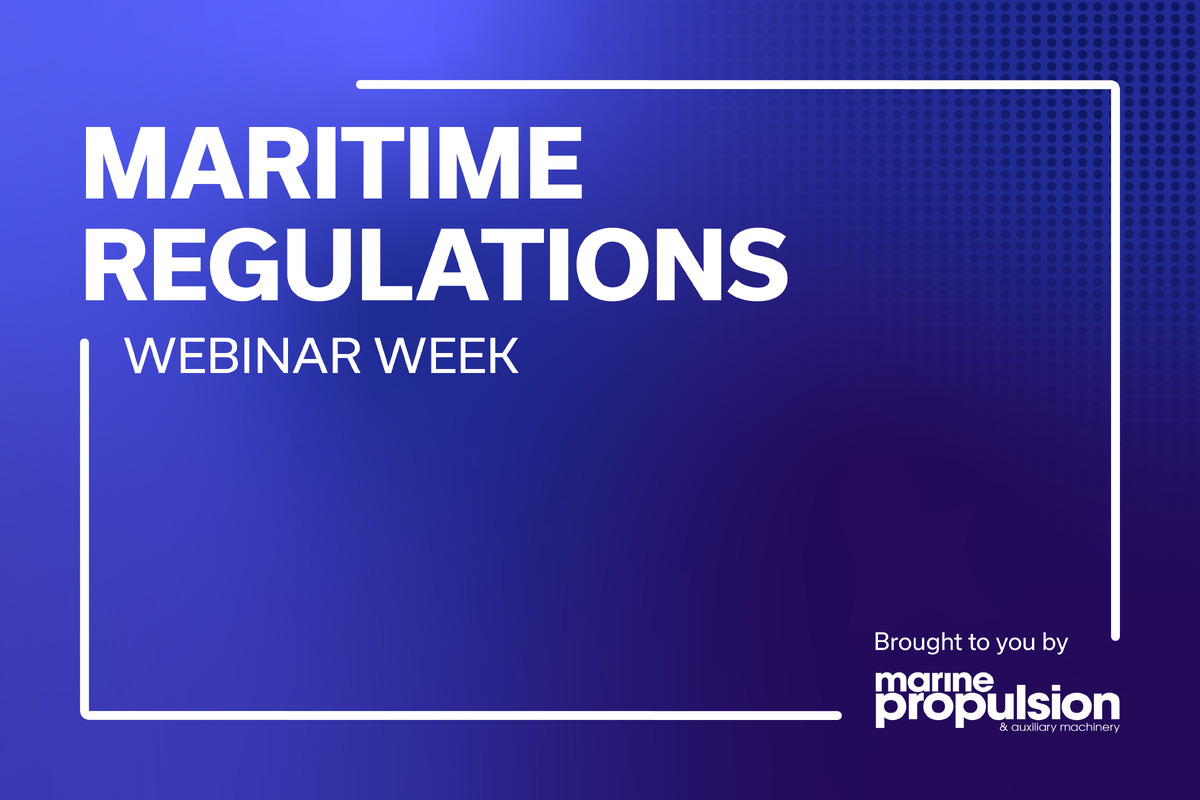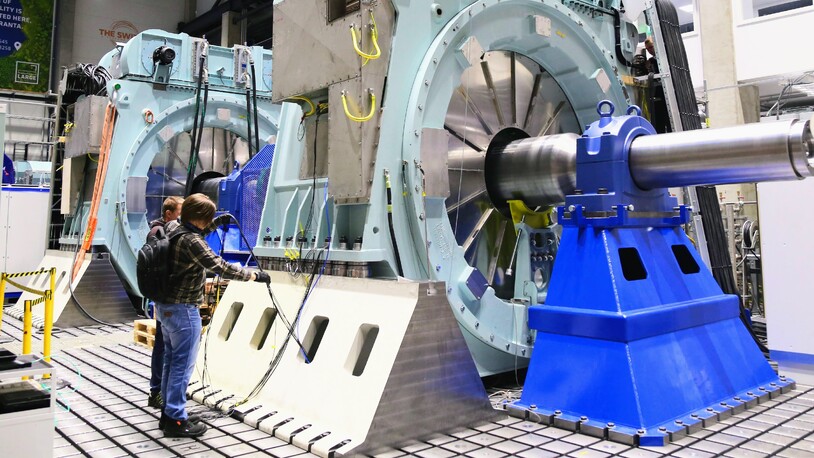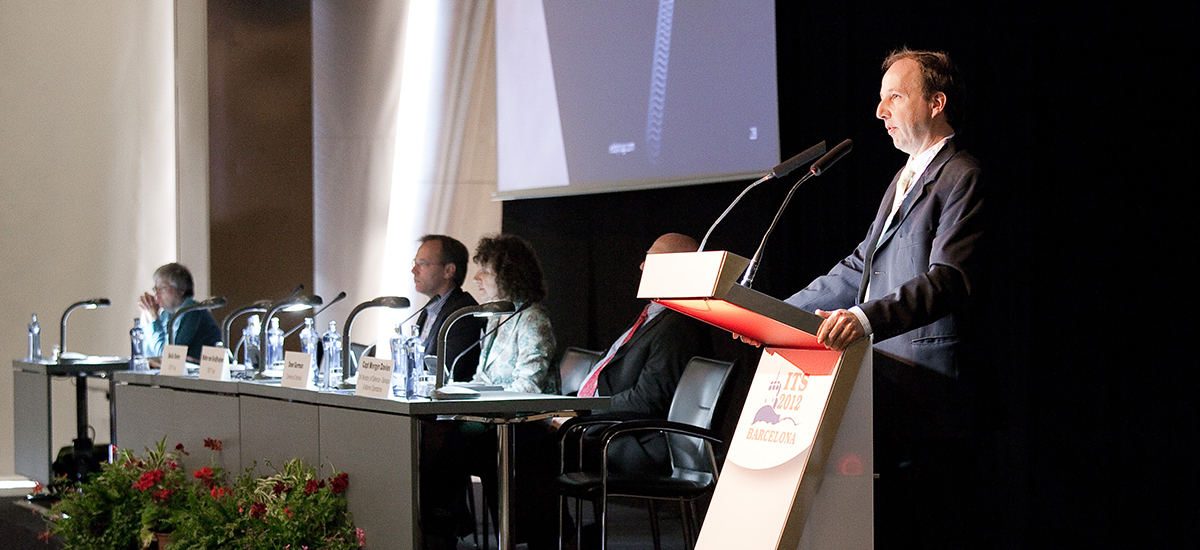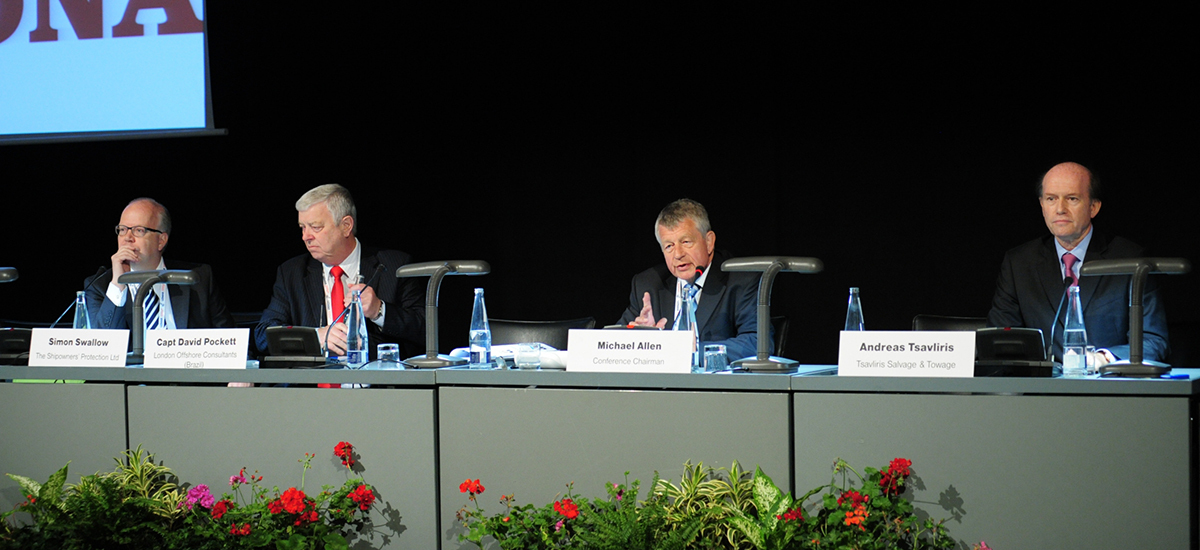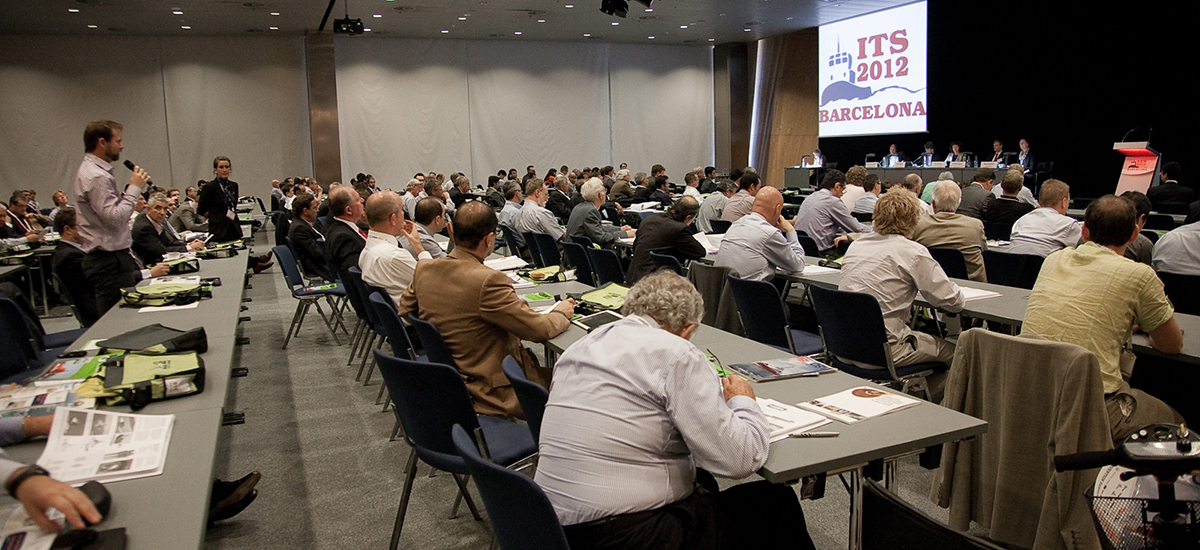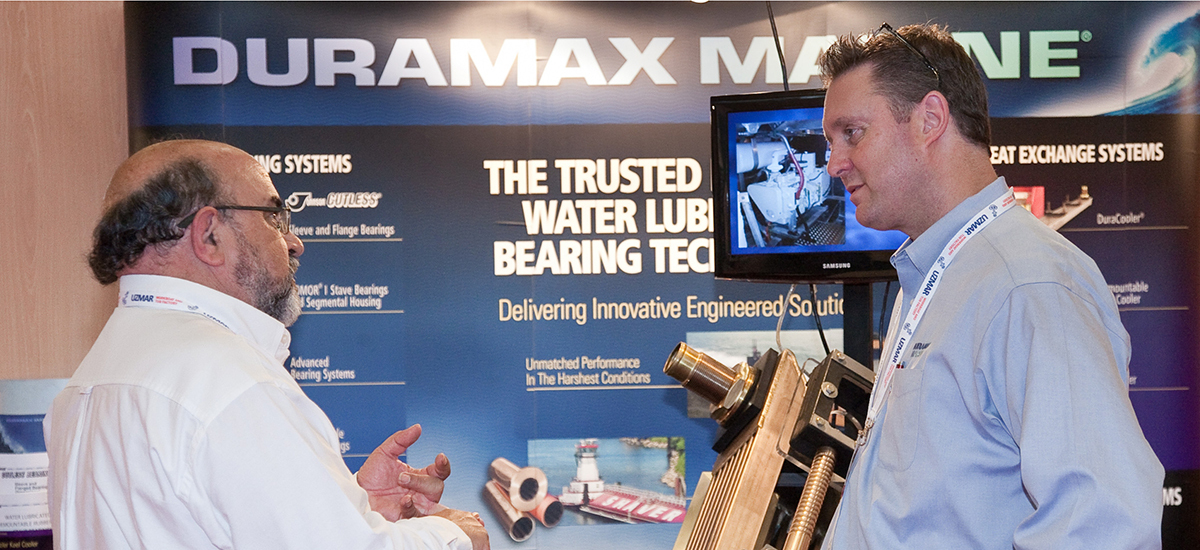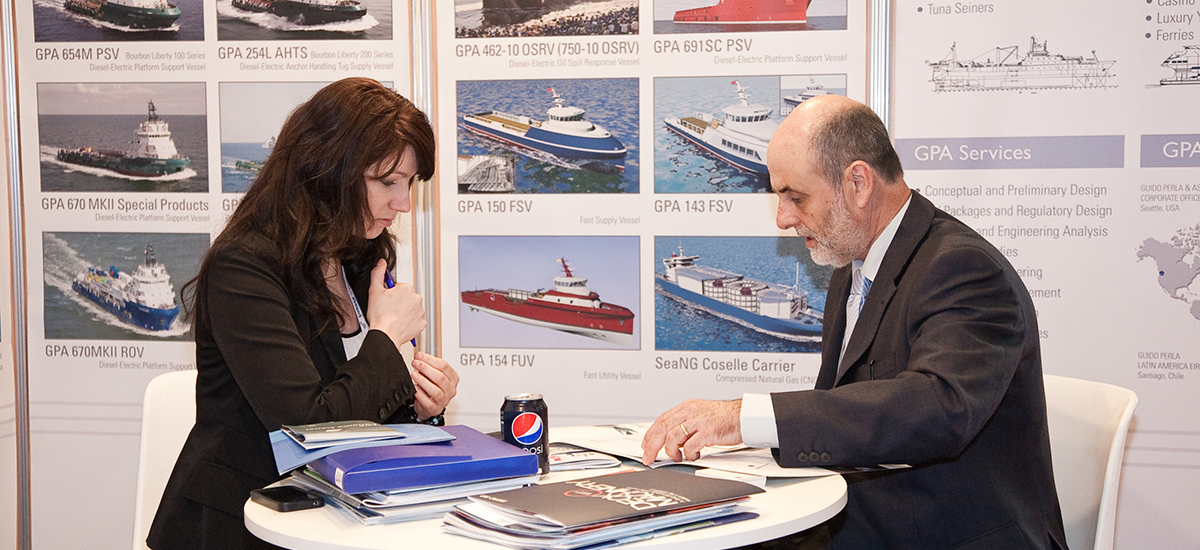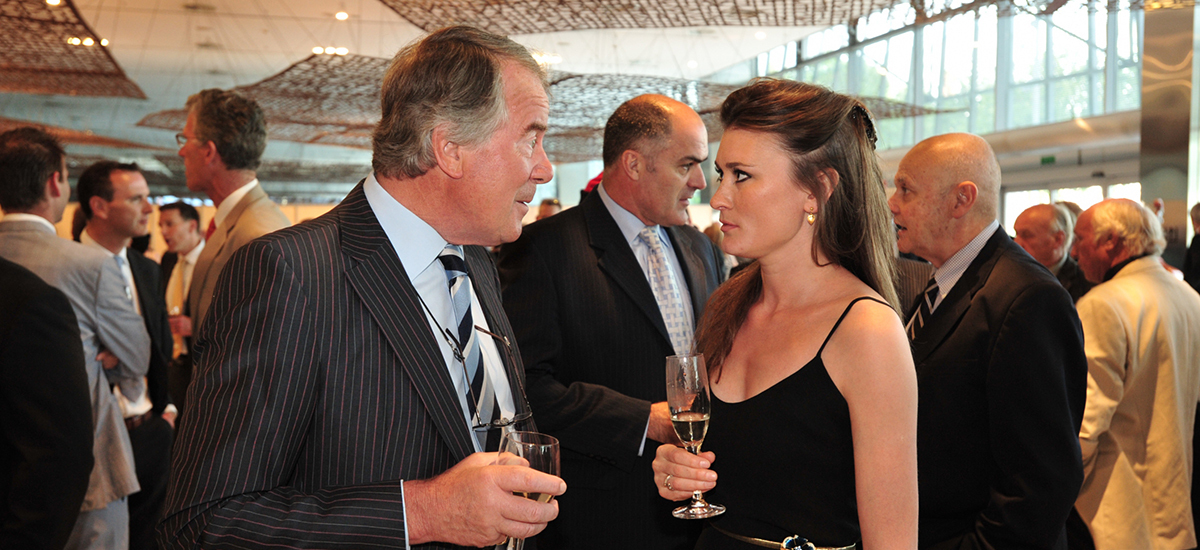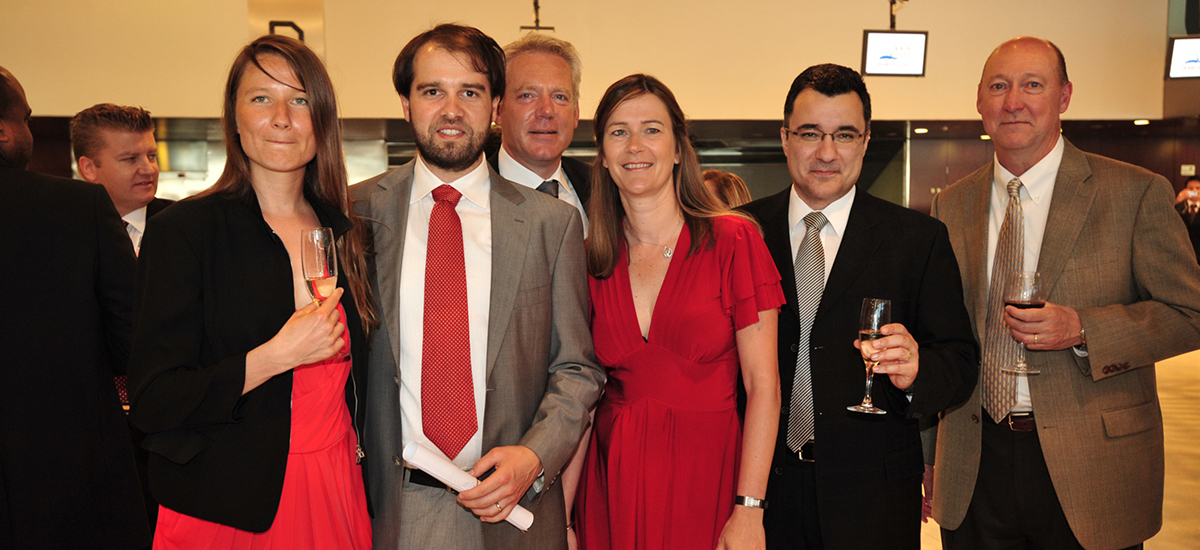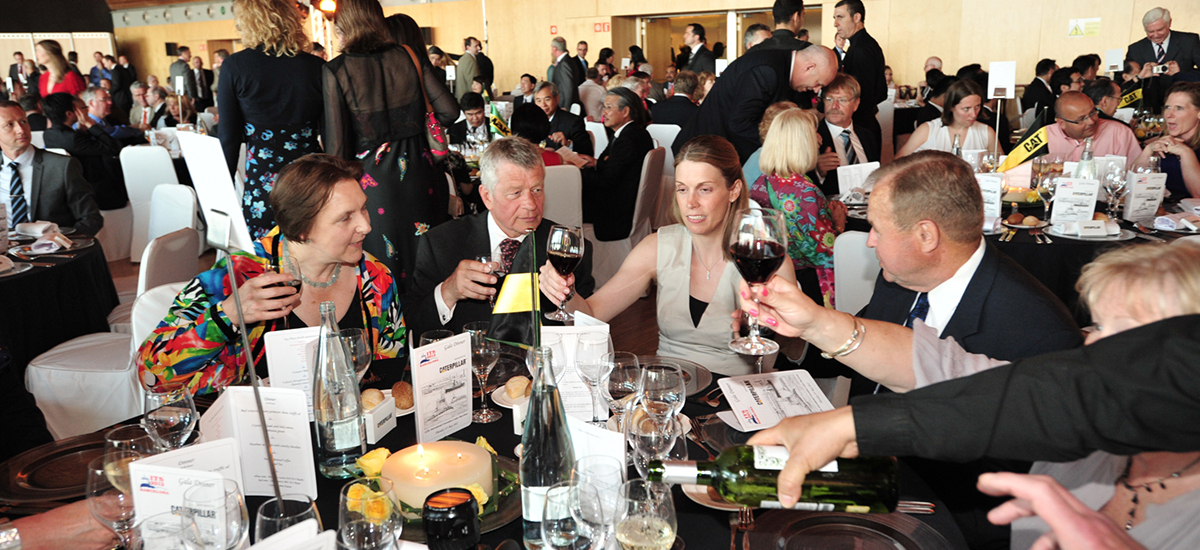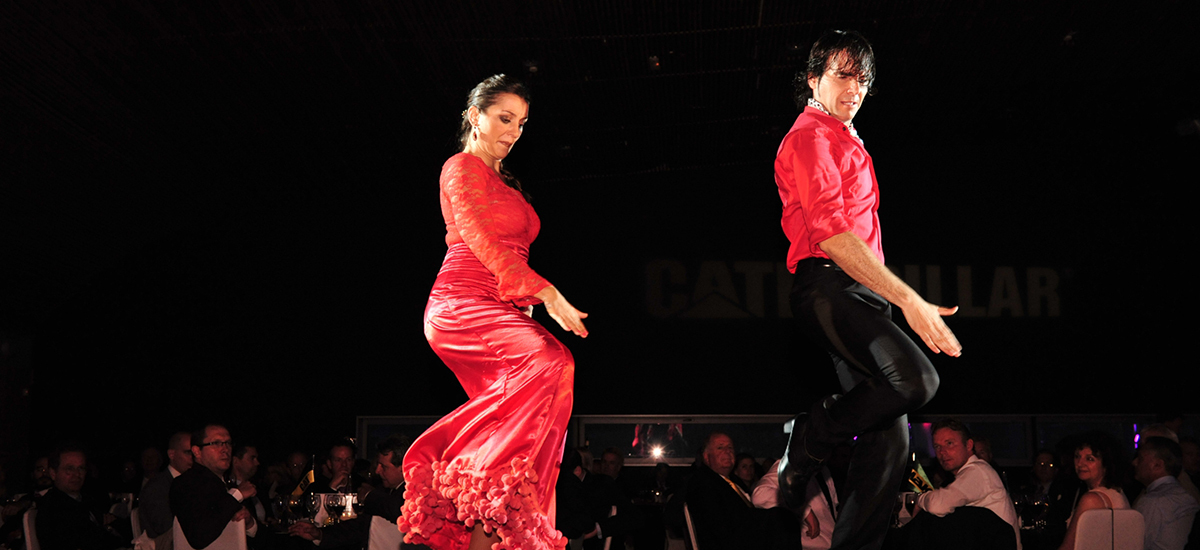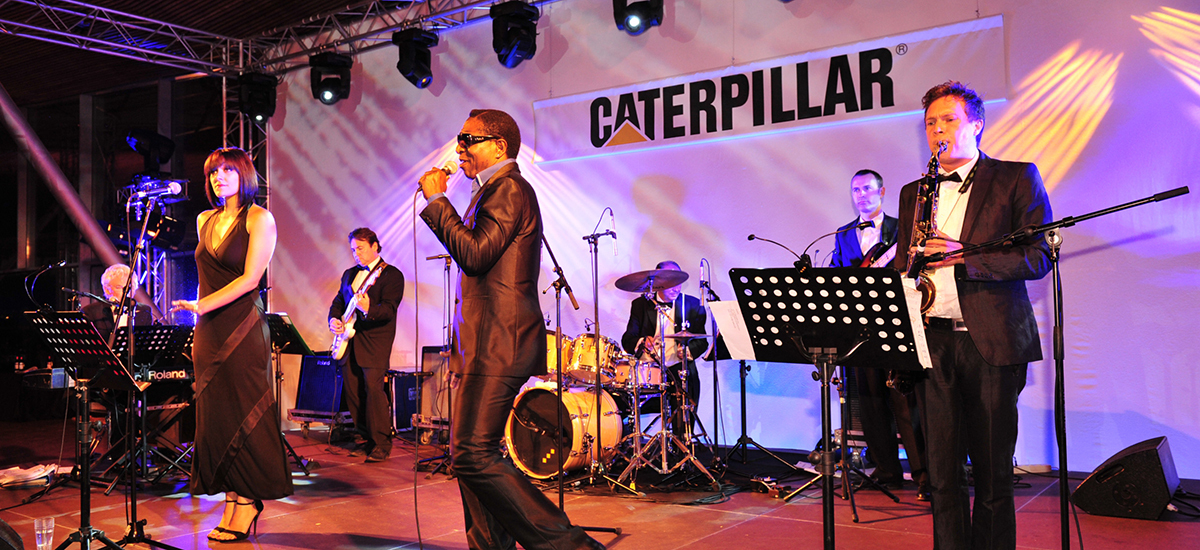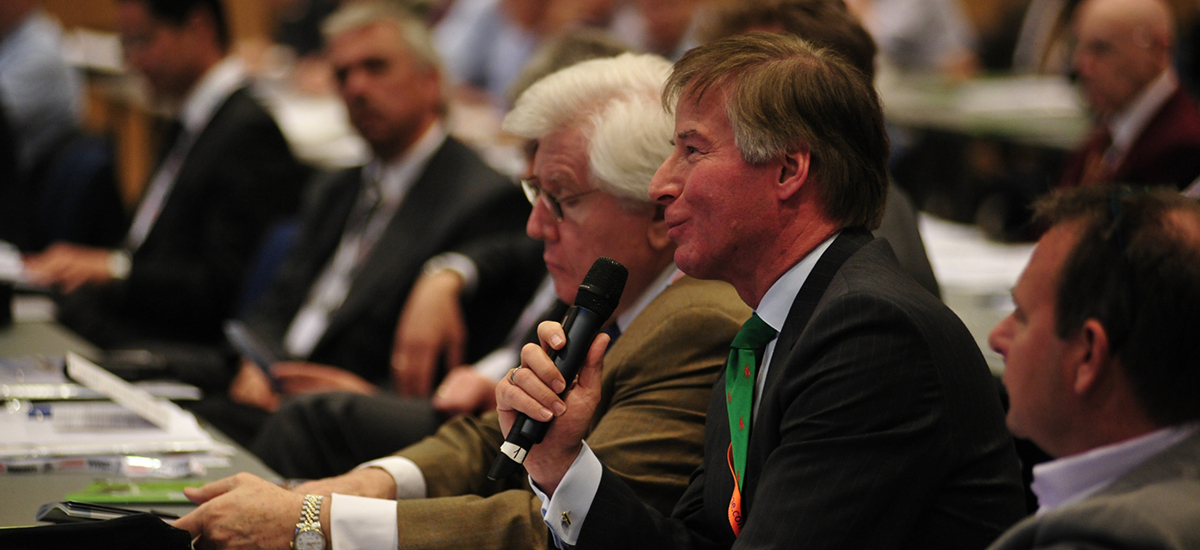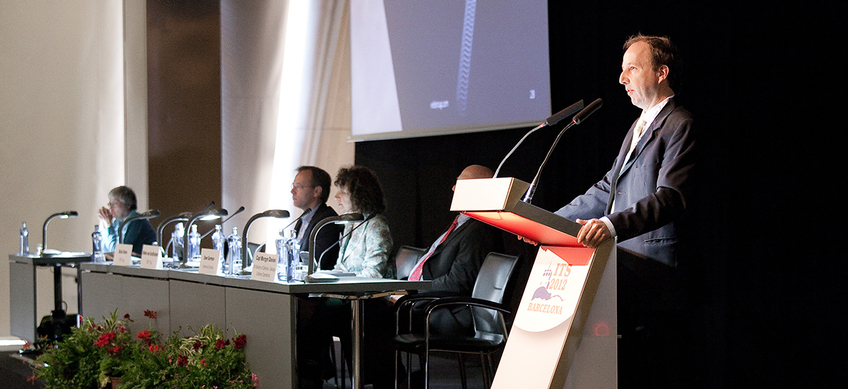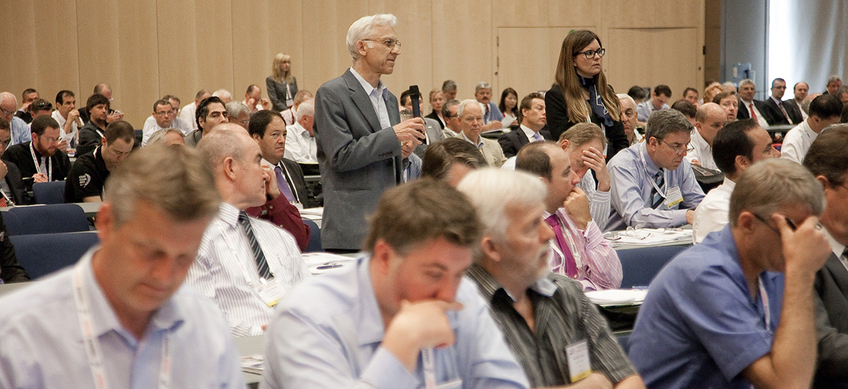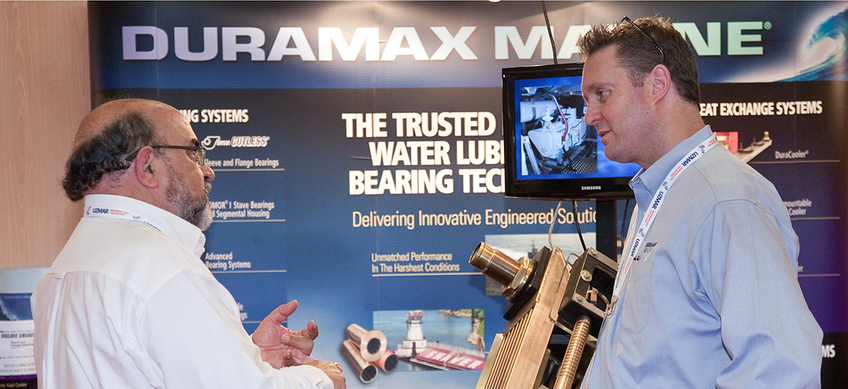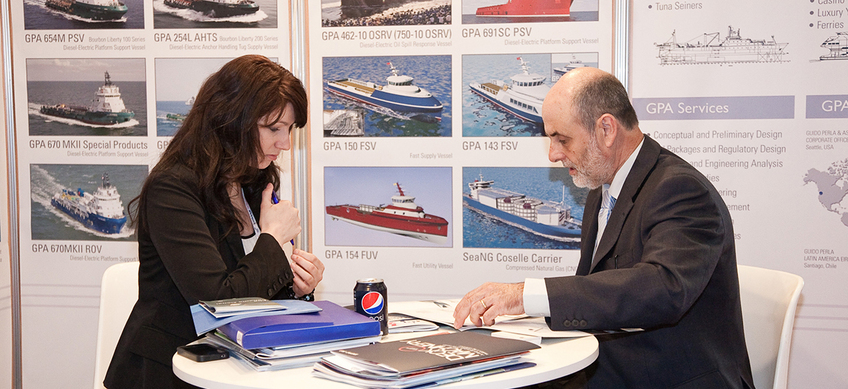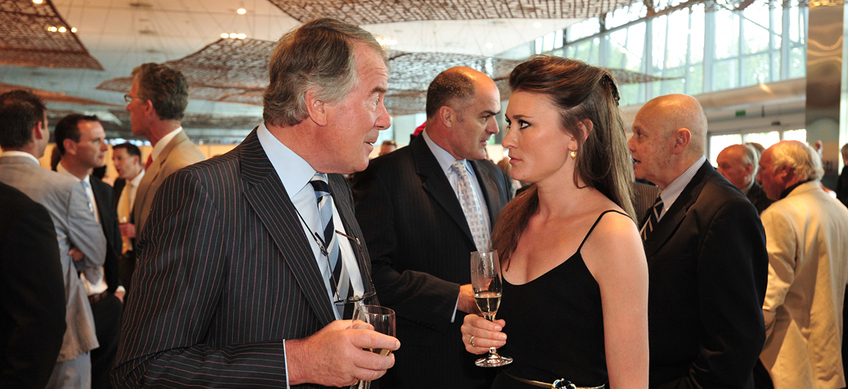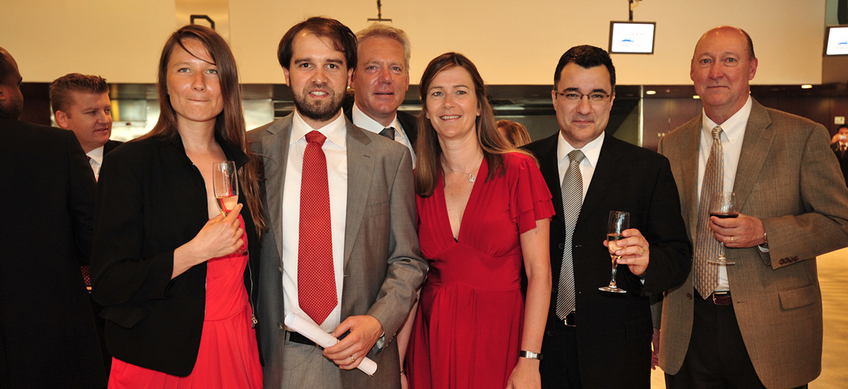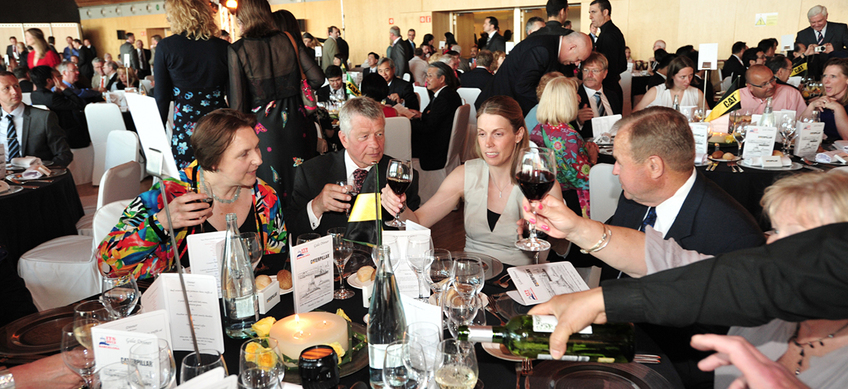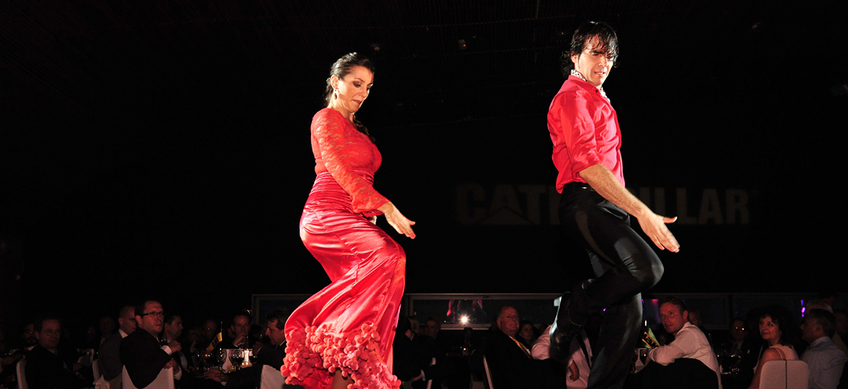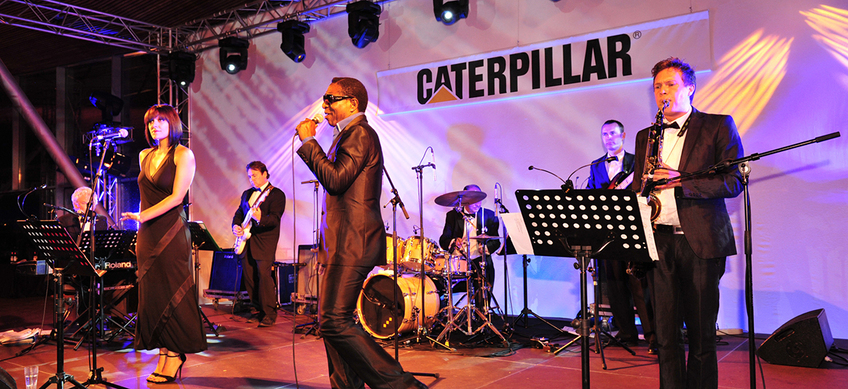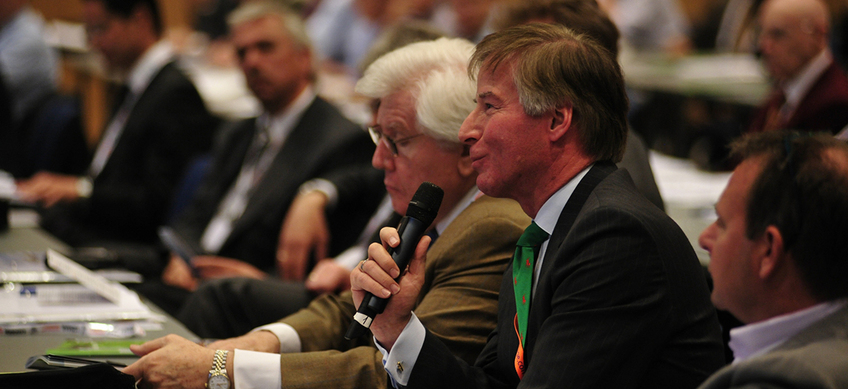ITS 2012 Barcelona

The International Tug, Salvage & OSV Convention celebrated its 44th year in Barcelona between 28th May - 1st June.
ITS last visited Spain a decade ago and in a space of only 10 years, the number of delegates has risen by more than a third to 426 and the number of exhibitors, at 112, has nearly doubled.
Many toasts were given and champagne shared during the week by key industry players at the 22nd ITS Convention, as alliances were formed, projects finalised and business deals made, proving once again that the conference is one of the most important networking events of the maritime calendar.
“Well done for an excellent show in Barcelona. We thoroughly enjoyed the events and appreciated your hard work. We made some excellent contacts.”
Simon Tatham, TugAdvise.
Damen Shipyards sponsored the ITS 2012 Golf Tournament and at the upbeat Welcome Cocktail Reception, also sponsored by Damen, introduced a new type of ASD tug, the 3212. The tug’s 85-tonne bollard pull range and revised hull form is the result of three years of research. Delegates were given the chance to explore the vessel and during the conference had the opportunity to venture out onto the water and experience the tug’s abilities for themselves.
The convention took place at the International Convention Centre, Barcelona - a vast, new conference space a stone’s throw from the beach. Lunches at the centre were sponsored by Uzmar, with tea and coffee breaks sponsored by MTU. The conference papers were well-received, addressing a number of issues at the forefront of the tug, salvage and OSV world.
The Costa Concordia incident captured the attention of both speakers and delegates, with questions arising as to whether the industry is fully-prepared for an incident on a larger scale. Research on the latest developments in resistant rope, a tugboat’s journey towards becoming the first hybrid tugboat in Europe, and the challenges surrounding vessel design in offshore wind farming were some of the other areas which sparked interest and debate.
At ITS, Robert Allan Ltd revealed that it will now act as the exclusive designer for all RotorTugs, with the line added to Robert Allan Ltd’s design portfolio.
Meanwhile, Corvus Energy announced a second siginificant conversion project with Foss Maritime Company, with Corvus replacing the existing battery pack aboard the hybrid harbour tug Carolyn Dorothy.
“[The ITS] team were very responsive and pleasant and certainly portrayed a very professional presence at the show and events. Corvus Energy had a really productive week and it is really becoming apparent how much traction we are now gaining in the commercial marine world.”
Grant Brown, Corvus Energy Ltd.
The AKA stand was bustling and busy at the announcement of the launch of Rotterdam-based towing company Kotug International’s RT Adriaan. In March this year, RT Adriaan re-entered operation in the Port of Rotterdam as an ’e-Kotug’, retrofitted with AKA’s XeroPoint hybrid propulsion system.
“We are very encouraged with the early results of the e-Kotug since its conversion to a hybrid Rotor®Tug and we are looking forward to realising the environmental and economical savings that are to come,”
Daan Merkelbach, manager, Nautical & QHSE, Kotug International.
The exhibition centre morphed from a business and networking environment to become a lively and relaxed social venue during the Armon Happy Hour and Holland Happy Hour, which ended two of the three busy conference days with a vibrant flourish.
The final day of papers was concluded with a Gala Dinner, sponsored by Caterpillar, which gave those in attendance a taste of the vibrant city of Barcelona. Street performers, mime artists and living statues set an enchanting scene before dinner was served and fiery flamenco dancers appeared. The evening was completed with a cabaret music act, dancing and presentation of silver dishes.
The Harbour Tour and Lunch was sponsored by the Shipowners’ Club and followed the picturesque Barcelona coastline with its sandy beaches, offering a glimpse of the bustling and busy port. Damen’s ASD tug accompanied the tour, further displaying its capabilities.
The Farewell Party, hosted by Remolcadores de Barcelona & Sar Remolcadores, offered a very civilised evening and a relaxing end to the conference, as two tugboats put on a display in the bright blue waters of the port below the elegant Grand Marina Hotel.
ITS 2012 offered delegates a rare chance to network with the key players in the industry, discuss the upcoming key issues sparking debate amongst professionals in the maritime world, expertly blending both business and social occasions. With ITS 2012 concluded and the stands packed away, further announcements and partnerships are expected on the back of the convention. After the success of the recent conference, already an air of anticipation surrounds the ITS 2014 convention, which is to take place in the vibrant, key location of Panama.
“It just gets better, and the new format worked very well.”
Alan Loynd, Brandscombe Marine Consultants Ltd.
The world’s largest gathering of Tug, Towage and Salvage experts
The ITS Convention and Exhibition started life as the International Tug Conference in 1969. At the 10th Conference in Sydney 1988, salvage was introduced into the programme for the first time, and the conference was renamed the International Tug and Salvage Convention and Exhibition.
The event, held every two years in a different location, is the world’s largest gathering of tug, towage, and salvage experts. Over the past 50 years, the convention has earned an enviable reputation for being the best of its kind. It attracts the most senior executives in the business, affording them a unique opportunity to meet, learn and discuss projects or contracts.
The convention has grown significantly and now attracts more than 1000 attendees and 100 exhibitors.
Since 1969, over 8,000 delegates and 1,200 exhibitors from 50 countries have taken part in the conventions.
"I realised that my entire career and the international success of our business have been inextricably linked with these conferences. Through them we have met the majority of our international clients, have been given the platform from which to draw attention to the important unique design developments initiated by this office, and been able to share ideas about the future of tug design and operations with a worldwide audience"
Robert Allan, Robert Allan Ltd
Programme
Inaugural Paper
SIXTE CAMBRA, Chairman, Barcelona Port Authority, Spain
Challenges Facing the Salvage Industry
ANDREAS TSAVLIRIS, Company Director, Tsavliris Salvage & Towage, UK
The salvage industry faces challenging times. Commercial pressures, the unpredictable nature of the business and a decline in the number of salvage cases make investment in equipment and vessels difficult. Shore-based authorities’ requirements and direction of salvage operations can mean longer and more complex jobs with the background threat of being criminalised for good intentions. Protecting the environment has been, rightly, an increasingly key priority and yet the salvor, often the only agency with the equipment and skill to make a difference to the outcome, does not always get a fair reward for their efforts. The role of Lloyd’s Open Form and the administration of the contract has been through recent change, but its principles have stood the test of time - what does it offer the shipping industry? There are also concerns about the practicalities of salving the new generation of massive container ships and cruise liners with thousands of passengers aboard. But the industry is vigorous - salvors are problem solvers and stand ready to continue to serve the marine community with innovation and dedication.
Emergency Towing Vessels - Necessary or Not?
DAVID POCKETT, Consultant, London Offshore Consultants (Brazil), Brazil
Prompted by the UK Government’s decision to cease contracts with the four ETVs in UK waters by September 2011, although two are currently reprieved, this paper considers the advent of ETVs and the rationale behind the concept. It looks at ETVs engaged today in Europe and elsewhere and then considers the benefits of ETVs with some summary statistics. The paper then looks at emergency towing assistance adopted by maritime nation states which do not have dedicated ETVs. Examples are given in the western and eastern hemisphere, as well as the Middle East and sub-continent. Emergency towing arrangement requirements on board commercial vessels and other emergency towing concepts are summarised. Finally, the paper draws together the general status of emergency towing today and poses the question of whether or not measures are adequate to meet the ever-increasing challenges presented when vessels are in distress.
Challenges Faced as a P&I Club from Risks Associated with the Towage, Salvage and Offshore Industry
SIMON SWALLOW, Commercial Director, The Shipowners’ Protection Ltd, UK
Insurers are often accused of being slow to react to change in the risk environment within which they work. The traditional liability insurers, generally in the form of the P&I Clubs, have to adapt to a more proactive approach in anticipation of changes in risks and the consequential impact on claims both in number and value. The Shipowners’ Club has, for some time, been concerned at the influx of new buildings and the consequential impact this can have on the offshore sector, and to a lesser extent the towage industry. Even a reduced freight market can have an impact as towing companies become more prepared to compromise on the traditional harbour and deep sea towage conditions. Oil majors attempt to pass on potentially huge liabilities to the offshore tugs and anchor-handlers. This comes with costs attached and insurers will have to seek premium increases or withdrawal from the market and reinsurers may even start to take greater control of what the direct insurers are doing. Crewing levels and competency remain increasing concerns - what skill sets are available as increasingly greater levels of technology are introduced to vessels which are in turn sold on to the secondhand markets? What is the capability of owners to source and train their crews in understanding the complex nature of highly manoeuvrable craft which are often required to work in close proximity to offshore platforms? Is it right that insurers should control these risks? The paper will briefly address and summarise these challenges, how they are being tackled by the P&I industry through a more proactive approach to risk, and how they impact on what is already a very competitive marine insurance environment.
Armon’s New Concept for Tractor Tug Skegs - Theoretical Analysis and Tank Testing
JUÁN MANUEL PAINO, General Manager, Armon Shipyards, Spain
Tractor tugs designed with azimuth thrusters and working with high angles relative to the towing wire, could have problems with directional stability. This is due to flow separation and creation of turbulent areas causing important changes of pressure which make it difficult to manoeuvre the tug. This effect, linked to a powerful vessel with a small L/B ratio, has prompted Armon Shipyard’s design team, in co-operation with Vicus DT, to carefully investigate a new concept of a special profile which enables the tractor tug to operate with high angles minimising the flow separation. The skeg has two main roles in a tractor tug: a) it affects directional stability and lift during indirect tow; and b) it acts as the main support of the tug during drydocking for periodic inspection, therefore, it is also important to study it from a structural point of view. Throughout the paper, a theoretical approximation using Computational Fluid Dynamics and Finite Element Method Analyses will be discussed.
Operator Focus - Maximum Up-Time, Lowest Operational Costs, Optimum Safety. A Guide to the Next Emissions Level and System Solutions
MICHAEL BRAUN, Tug & Salvage Segment Manager, Caterpillar Marine Power Systems, Germany
FRANK KIRCHER, Division Manager, Systems Integration, Caterpillar Marine Power Systems, Germany
The operators’ focus and global emissions regulations drive engine manufacturers to continuously adjust their strategies and improve solutions to always be in the ’new normal’. With emphasis on maximum up-time, lowest operational costs and optimum safety, the power systems equipment has to simultaneously serve operators, comply with regulations and deliver continuously premium performance. This paper will guide you through the different solutions.
Technology Transfer - Taking ’Goal-Based’ Design from the Salvage Industry to the Oil & Gas Sector
MOYA CRAWFORD, Managing Director, Deep Tek Ltd, UK
Salvage in all its forms has a very specific way of working. The skill in mastering events that by their very nature are unplanned, where information and data is often scant and the situation has to be dealt with as it is, not as one should like it to be, leads to a very different way of thinking. Fundamentally, it is ’goal-based’. Innovative design work for deep water cargo recovery, which was developed on this approach, has now been transferred to the revolutionary AX-S Light Well Intervention System designed to 3,000m water depth. This is a major breakthrough, bolstered by the recently introduced DNV Recommended Practice for the Development of New Technology, which gives a framework for ’goal-based design’ from the salvage industry to penetrate more conventional markets in the oil & gas sector.
Voith Schneider Propeller for Offshore Applications - Special Hydrodynamic Effects
DR DIRK JÜRGENS, Head of Research & Development Department, Voith Turbo Schneider Propulsion GmbH & Co KG, Germany
Vessels propelled by Voith Schneider Propellers (VSP) are offering new features for offshore applications. The first tug with Voith Roll Stabilisation and special DP features for the offshore industry has been successfully operating since 2010. The paper will show the latest model test results, numerical simulations and full-scale measurements showing the behaviour of VSP equipped vessels in offshore relevant conditions. Additionally, the influence of hydrodynamic effects on mechanical loads and on the reliability of thruster parts will be discussed.
Hybrid Systems - Aiming for a Better Compromise
ARNSTEIN EKNES, Segment Director, Special Ships, Det Norske Veritas AS, Norway
BJORN JOHAN VARTDAL, Principal Engineer, Det Norske Veritas AS, Norway
There are several vessel types where different power sources and power transmission technologies have been used. The motivation to select a hybrid solution can vary greatly, from performance-related criteria to operational optimisation of capacities and capabilities. An optimal solution could be a combination of ’the best from two technologies’ - or in other words a hybrid. Making such combinations would also trigger new challenges to integrate components and systems, and to ensure the benefits of each system are maintained. When connecting the words hybrid and tug, we have to balance the benefits of having sufficient capability with the benefits of having access to cleaner fuels. With many tugs operating in emission-control areas where stricter regulations are being enforced, a challenge for many operators will be to identify which technologies are available - and at what cost eg investment versus operation, impact of local taxation and type of fuel contracts etc. To reach the optimum balance between performance and economy, power capacity versus emissions or fuel consumption versus cost, are just a few examples where the goal is to ’find the best compromise’. DNV is engaged in a number of hybrid projects for several vessel types, and this presentation will outline both lessons learned and best practice on how to handle such systems, from concept, through design, to testing and operation.
Damen ASD Tug 3212 Escort - Hardware for Pushing and Pulling in Offshore Conditions
JOCHEM DE JONG, Senior Project Engineer, Research, Damen Shipyards, The Netherlands
ROLPH HIJDRA, Project Engineer, Research, Damen Shipyards, The Netherlands
The aim of this paper is to describe the research done on the innovative Damen ASD tug 3212. This ASD tug complies with the demand for compact offshore tugs. Model tests have been carried out to verify motion and acceleration in waves. Based on the performance of the ASD tug 3212, winch capacities and loads have been determined for the deck layout, fairlead and fender design. Factory tests in combination with state-of-the-art (non-linear) FEM analysis have led to new insights and an optimised bow fender and fairlead design.
How Experience and Simulation Techniques Improve Tug Effectiveness and Safety at Hadera Open-Sea Terminal
CAPT SHLOMO UZAN, Hadera Port Pilot, Port of Hadera, Israel
Port of Hadera, an open-sea port, planned to accommodate fully-loaded, cape-size bulk carriers, with a design based purely on theoretical criteria, has considerably improved in efficiency due to the assimilation of extensive experience accumulated over the past 30 years. Simulator training of the port pilots and tug captains brought additional improvement in ship and tug handling, thus contributing to port efficiency, primarily in economical, professional and safety aspects, and therefore protecting property and life. Driven, amongst other things, by changes in market/client’s requirements, original design parameters were reviewed, and operating concepts, supported by modern equipment, were evolved and tested; this resulted in safely increased output. This paper will review Hadera’s development and achievements, and will show that the port operates at markedly improved efficiencies and output.
Crowley’s Ocean Class Tugs - Lessons Learned in Design and Construction
JONATHAN PARROTT, Vice President, New Design Development, Jensen Maritime Consultants Inc, USA
Over the course of three years, Crowley Vessel Management Systems, Jensen Maritime and Bollinger Shipyards have been involved with the design and construction of the new Crowley Ocean Class tugs. These tugs are the first ocean-going, high horsepower tugs that Crowley has built since their Invader Class tugs of the late ’60s and ’70s, and are also some of the first large line-haul tugs to be built in the US in recent times. Four tugs are now under contract with Bollinger, with the first two to be delivered by the end of 2011. The second pair have design changes to add DP2 capability. The paper will discuss the process Crowley and Jensen went through in the design development, and the process of construction with Bollinger.
Salvage Claims: Back to Basics
SIMON TATHAM, Partner, TugAdvise, UK
This paper will follow the story of three very different salvage cases and their outcomes. Currently, the industry is shying away from salvage contracts, under pressure from underwriters to fix a lump sum, and from accountants to maximise an operators’ cash flow, and with some justification. This paper, however, seeks to address those cases where a salvage contract is the right solution, and what legal procedure is recommended to ensure a speedy and cost-effective resolution. Simon Tatham addresses the conference with over 30 years of experience as a solicitor advising on tug, towing and salvage issues.
Marine Casualty Response Expanded in the Public Interest
CAPT JIM SHIRLEY, Principal Consultant, JTS Marine LLC, USA
Marine casualties have occurred since the early days of maritime commerce. Legal regimes were set up to deal with those responses by salvors and others, and these have changed gradually over the centuries to take into account improved tools and technological developments, changing commercial considerations and marine insurance models, and the need to respond to changes in the political climate. Response was originally directed at saving lives and property, and the legal systems were designed to discourage bad conduct such as plunder of shipwrecks, and to encourage good conduct by rewarding the rescue of life and the salvage of property. Changes over the centuries have been mostly directed at getting those things done more efficiently. However, during the past half century, we have witnessed dramatic changes of a different sort, rooted largely in the public awakening to environmental and other public interest concerns. This paper will trace the evolution of this valuable service, and particularly the changes in the role of the salvor in the services he provides, as marine casualty response has become more centrally focused on protection of the public welfare.
Use of Offshore Support Vessels and Craft in Marine Salvage and Wreck Removal Operations
MARK HODDINOTT, General Manager, International Salvage Union, UK
The decline in dedicated salvage tugs, the increase in the size of vessels and scale of salvage and wreck removal operations has led to an increase in the use of offshore support vessels and craft in marine salvage and wreck removal operations. This paper examines the growth, reliance and innovation associated with the use of offshore support vessels by major salvors. It also examines whether such use is a cost-effective solution for ship owners and their insurers, or whether salvors need to invest in similar or specialist vessels.
The ART 85-35 Class Offshore Support Rotor® Tug Fleet for Port Hedland, Australia
ROBERT ALLAN, Executive Chairman, Robert Allan Ltd, Canada
TODD BARBER, Senior Naval Architect, Principal, Robert Allan Ltd, Canada
JAN VAN KASTEREN, Technical Director, KST BV (Rotortug), The Netherlands
In early 2011, KST BV was awarded the contract to provide the design for a new series of extremely powerful and unique bulk terminal support tugs for BHP Billiton’s ore export terminal in NW Australia. The comprehensive design work for these new Rotor tugs was subcontracted to Robert Allan Ltd in order to incorporate the latter’s extensive design tug expertise, as well as the unique RAstar hull form developed by the latter into these major escort tugs. The paper looks at the background operational requirements for this fleet of 16 tugs, the design evolution process including model testing, and the final design details available as the project was tendered in early 2012.
KST BV (Rotortug) Special Presentation - Friction-Free Towing: A New Development to Eliminate Friction when Towing in Waves with Render/Recover Winches
ARIE AALBERS, Independent Naval Architect, Aalbers Ship Design, The Netherlands
TON KOOREN, Executive Chairman, KST BV (Rotortug), The Netherlands
The Efficient Double-Ended Dynamic (EDDY) Tug Explained
BALDO DIELEN, Partner, EDDY Tugs, Brazil
WALTER VAN GRUIJTHUIJSEN, Partner, EDDY Tugs, The Netherlands
After four years of intensive development, a novel tug type was recently launched that simultaneously offers improved safety, performance and economy. Overall emissions are reduced due to significantly lower fuel consumption, without the need for complex propulsion systems. These Efficient Double-ended Dynamic (EDDY) tugs also are available in LNG and hybrid versions, to further improve emissions and fuel cost. All EDDY versions are based on the same patented DNA of an advanced double-ended, low-drag, hull shape with a towing point inbetween two azimuthal propulsion units on the centreline, one forward and one aft. Handling is entirely intuitive which simplifies training and increases safety. The tugs are extremely manoeuvrable and configured for effective ship-assist operations as well as high performance escort towing. Stern tug performance exceeds that of ASD tugs of equivalent power. As a bow tug, it performs equally well as the EDDY stern tugs. This allows for fleet standardisation with just a single tug type.
Action Salvage Vessel (ASV) - Current and Future Requirements for Military Utilisation of Commercial Offshore Support Vessels
CAPT MORGYN DAVIES OBE, Chief Salvage & Mooring Officer, UK Ministry of Defence - Salvage & Marine Operations, UK
The salvage and marine operations group of the UK Ministry of Defence has extensive experience in the charter of commercially-supplied offshore support vessels and their adaptation to deliver a range of military requirements. Since the UK Strategic Defence and Security Review (SDSR), the future requirements for chartered vessels are becoming apparent, especially for delivery of forward support functions to the ’Future Navy’. The paper considers some of the basic issues associated with military salvage and the scope of the military requirement and its relevance to collaborative ventures with the commercial sector. It covers key lessons learnt in the military sector from a range of operations and future development intent. The paper explores the potential developments in the military support area and the opportunity for commercially-designed and built offshore support vessels to meet these requirements.
Conversion of Kotug’s RT Adriaan to become Europe’s First Hybrid Tugboat
PAUL JAMER, Vice President, Corporate Department, Aspin Kemp & Associates, Canada
This paper will discuss the conversion of RT Adriaan from conventional to hybrid propulsion and the technological challenges that have been overcome. The vessel is the first hybrid tug in Europe and also the first hybrid tug to be built to class standards (Lloyd’s Register). Rotor tugs are unique in the marine industry as they have two azimuthing drives forward and one aft as opposed to the more conventional Z-Drive vessels with only two drives at the stern. The result is a highly manoeuvrable boat with excellent stability characteristics. The addition of a hybrid propulsion system further enhances the vessel’s performance and operational capabilities while providing dramatically increased efficiency. The additional flexibility with respect to propulsion plant configuration enables the vessel to run the minimum number of diesels required at any given time. The use of advanced energy storage also permits extended periods of operation where no diesel engines are required.
Design and Build Challenges for Vessels in Offshore Wind Farming
RASMUS STUTE, Vice President Approval Services East Asia, Germanischer Lloyd, Germany
Offshore wind farming is a rapidly expanding market with an enormous growth rate in Europe. Recent publications see a similar potential in the US and China. This paper will focus on vessels supporting the construction, maintenance and repair of offshore wind farms. The demand for specialist vessels engaged in offshore wind farming will be elaborated upon by consideration of market analysis. The market demand will then be translated into some vessel specifications, to give examples of ships fit for the purpose to install offshore wind turbines under harsh conditions in the waters of the North Sea.
Girting/Tripping
CAPT GRANT LIVINGSTONE, Pilot, Long Beach Pilots, USA
CAPT GEORGE H LIVINGSTONE, Pilot, San Francisco Bar Pilots, USA
The topic of ’girting/tripping’ has been much discussed over the years at ITS but as we continue to see accidents around the world involving tugs being tripped, it was thought appropriate to re-visit the subject this year at Barcelona. Capt George H and Grant H Livingstone will present a paper on girting/tripping using a case study format covering three aspects of this dramatic and dangerous issue: 1) The most recognised area of ’harbor tug tripping’ during ship assist operations; 2) Harbor tug tripping during ’short wire/cable’ towing operations; 3) Girting in extreme weather when engaged in offshore towing operations. There are few circumstances more dangerous while towing than having the tow trip the towing vessel, ie the towing vessel losing control of that which it is towing. The towing vessel then becomes trapped/ dragged along by whatever it was towing - a dangerous situation where seconds, not minutes, is all the towing master has to avoid catastrophe. The purpose of this paper is to two-fold: 1) To share with the audience the very real dangers of girting/tripping; 2) To provide a minimum of critical tools needed to avoid girting/tripping situations.
Ocean Towing and the Double Tow Dilemma - A Solution at Last
KENT STEWART, Executive Director, Maritime Engineers Pty Ltd, Australia
For years, controversy has surrounded the risk in conducting and warranting double tows of transport barges. A breakthrough has now been made which will negate this risk and open the doors to a safer and more efficient handling of double tows. The author has developed an innovation which, when fitted to barges, will revolutionise tug and barge transport and consequently ease the insurance rates on both single and double tows while providing a last line of defence in the worst case scenario - a loaded barge drifting towards the coast.
High-Temperature Resistant Rope
DANIELLE STENVERS, Manager Research & Development, Samson, USA
With the critical high temperature and engineering properties intrinsic to aramid fibres, rope manufacturers have been using them with great success in a variety of applications. However, aramid-fibre ropes by themselves cannot withstand direct flames, which is a requirement in some applications. In response to the petroleum-shipping industry’s need for a synthetic emergency tow-off pendant (ETOP), also known as ’fire wire’, Samson, Teijin Aramid, and Passive Fire Protection Partners have worked together to produce a high-temperature resistant rope which, when combined with a specialised coating technology, can replace fire wires in high-heat environments, including direct flames. This paper will give an overview of the high-temperature resistant rope developed for the petroleum shipping industry that is being used in the field to tow tankers away from terminals by tugboats in cases of emergency. It will also discuss the advantages of the product as it is used in this application and provide observations made about the product’s performance in field trials.
Hybrid Battery Propulsion System - A Sustainable and Energy-Conscious Propulsion and Power System
MARTIJN BERKHOFF, Consultant Electrical Systems, Imtech Marine, The Netherlands
CLAUDE MESSIAEN, President, Techsol Marine, Canada
In this paper, we present an innovatory solution for a propulsion and power system on a support platform. Our starting point is the reduction of fuel consumption, the reduction of greenhouse gas emissions and an increase in reliability in all aspects. The propulsion and power system is based upon a diesel-electric propulsion system. The generation and main distribution of energy is supplied by means of a DC-grid. In addition to contemporary energy generators such as diesel-generator sets or gas turbine generator sets, alternative energy generation from fuel-cells, solar energy and wind energy will be taken into account. In order to balance energy supply and demand, energy storage is needed. This is fulfilled by large battery systems, which can store large amounts of energy. The balance of energy generation, storage and consumption is regulated by means of an innovatory energy management process based on an energy trading system. In the second part of the paper, we will take a closer look at lithium-ion battery energy storage, and will explain more about the technology as it is relatively new on ships. There are many misconceptions about lithium-ion batteries, but with the proper knowledge, this technology can be safely introduced as a propulsion and peak-shaving system for ships.
Report
The International Tug, Salvage & OSV Convention celebrated its 44th year in Barcelona between 28th May - 1st June.
ITS last visited Spain a decade ago and in a space of only 10 years, the number of delegates has risen by more than a third to 426 and the number of exhibitors, at 112, has nearly doubled.
Many toasts were given and champagne shared during the week by key industry players at the 22nd ITS Convention, as alliances were formed, projects finalised and business deals made, proving once again that the conference is one of the most important networking events of the maritime calendar.
“Well done for an excellent show in Barcelona. We thoroughly enjoyed the events and appreciated your hard work. We made some excellent contacts.”
Simon Tatham, TugAdvise.
Damen Shipyards sponsored the ITS 2012 Golf Tournament and at the upbeat Welcome Cocktail Reception, also sponsored by Damen, introduced a new type of ASD tug, the 3212. The tug’s 85-tonne bollard pull range and revised hull form is the result of three years of research. Delegates were given the chance to explore the vessel and during the conference had the opportunity to venture out onto the water and experience the tug’s abilities for themselves.
The convention took place at the International Convention Centre, Barcelona - a vast, new conference space a stone’s throw from the beach. Lunches at the centre were sponsored by Uzmar, with tea and coffee breaks sponsored by MTU. The conference papers were well-received, addressing a number of issues at the forefront of the tug, salvage and OSV world.
The Costa Concordia incident captured the attention of both speakers and delegates, with questions arising as to whether the industry is fully-prepared for an incident on a larger scale. Research on the latest developments in resistant rope, a tugboat’s journey towards becoming the first hybrid tugboat in Europe, and the challenges surrounding vessel design in offshore wind farming were some of the other areas which sparked interest and debate.
At ITS, Robert Allan Ltd revealed that it will now act as the exclusive designer for all RotorTugs, with the line added to Robert Allan Ltd’s design portfolio.
Meanwhile, Corvus Energy announced a second siginificant conversion project with Foss Maritime Company, with Corvus replacing the existing battery pack aboard the hybrid harbour tug Carolyn Dorothy.
“[The ITS] team were very responsive and pleasant and certainly portrayed a very professional presence at the show and events. Corvus Energy had a really productive week and it is really becoming apparent how much traction we are now gaining in the commercial marine world.”
Grant Brown, Corvus Energy Ltd.
The AKA stand was bustling and busy at the announcement of the launch of Rotterdam-based towing company Kotug International’s RT Adriaan. In March this year, RT Adriaan re-entered operation in the Port of Rotterdam as an ’e-Kotug’, retrofitted with AKA’s XeroPoint hybrid propulsion system.
“We are very encouraged with the early results of the e-Kotug since its conversion to a hybrid Rotor®Tug and we are looking forward to realising the environmental and economical savings that are to come,”
Daan Merkelbach, manager, Nautical & QHSE, Kotug International.
The exhibition centre morphed from a business and networking environment to become a lively and relaxed social venue during the Armon Happy Hour and Holland Happy Hour, which ended two of the three busy conference days with a vibrant flourish.
The final day of papers was concluded with a Gala Dinner, sponsored by Caterpillar, which gave those in attendance a taste of the vibrant city of Barcelona. Street performers, mime artists and living statues set an enchanting scene before dinner was served and fiery flamenco dancers appeared. The evening was completed with a cabaret music act, dancing and presentation of silver dishes.
The Harbour Tour and Lunch was sponsored by the Shipowners’ Club and followed the picturesque Barcelona coastline with its sandy beaches, offering a glimpse of the bustling and busy port. Damen’s ASD tug accompanied the tour, further displaying its capabilities.
The Farewell Party, hosted by Remolcadores de Barcelona & Sar Remolcadores, offered a very civilised evening and a relaxing end to the conference, as two tugboats put on a display in the bright blue waters of the port below the elegant Grand Marina Hotel.
ITS 2012 offered delegates a rare chance to network with the key players in the industry, discuss the upcoming key issues sparking debate amongst professionals in the maritime world, expertly blending both business and social occasions. With ITS 2012 concluded and the stands packed away, further announcements and partnerships are expected on the back of the convention. After the success of the recent conference, already an air of anticipation surrounds the ITS 2014 convention, which is to take place in the vibrant, key location of Panama.
“It just gets better, and the new format worked very well.”
Alan Loynd, Brandscombe Marine Consultants Ltd.
